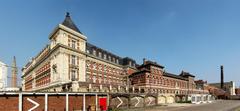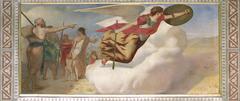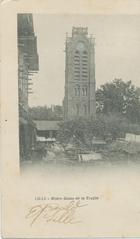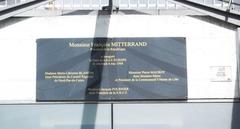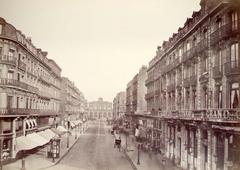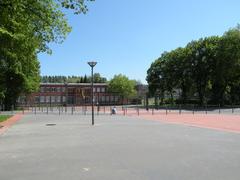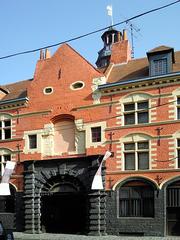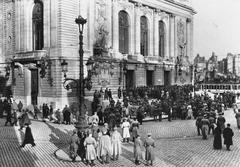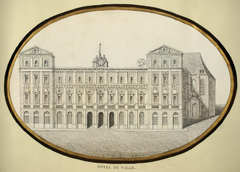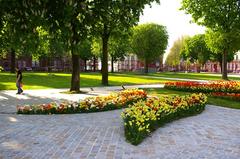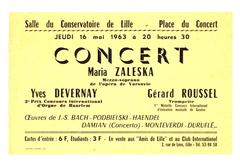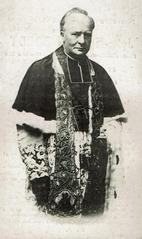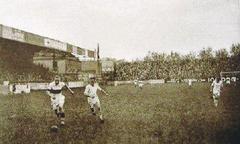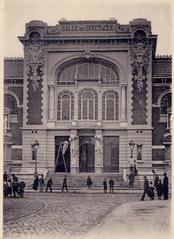Porte de Douai Lille: Visiting Hours, Tickets, and Complete Guide to Lille’s Historical Gateway
Date: 04/07/2025
Introduction
Porte de Douai is a historically significant district in southern Lille, France, known for its rich past as a fortified city gate and its vibrant present as a bustling urban hub. While the original 17th-century gate, designed by the renowned engineer Vauban, was demolished in the 19th century, its legacy lives on in the name, the metro station (Porte de Douai - Jardin des Plantes), and the dynamic neighborhoods that surround it. Today, visitors experience a seamless blend of history, culture, green spaces, and local life.
This comprehensive guide delivers everything you need to know for an enriching visit: historical context, visiting hours, ticket policies, transport options, accessibility, nearby attractions, and practical tips. Whether you’re a history enthusiast, an urban explorer, or a curious traveler, Porte de Douai offers a unique window into Lille’s evolving identity.
For up-to-date information, maps, and exclusive guided tours, consult the official Lille tourism resources or download the Audiala app. (Lille Tourism, Wikipedia Porte de Douai, Audiala)
Table of Contents
- Introduction
- History and Cultural Significance
- Visiting Hours and Ticket Information
- Transport and Accessibility
- Guided Tours and Special Events
- Navigating the Area
- Amenities and Facilities
- Best Times to Visit
- Local Culture & Atmosphere
- Safety and Practical Tips
- Accessibility and Inclusivity
- Nearby Points of Interest
- Dining and Accommodation
- Frequently Asked Questions
- Conclusion
- References
History and Cultural Significance
Porte de Douai was one of Lille’s main fortified gates, constructed in the 17th century as part of the city’s defense system under Vauban. Strategically positioned to control the southern route to Douai, it stood as a symbol of Lille’s resilience and civic pride. Over time, the gate witnessed Lille’s transformation from a military stronghold to a modern metropolis. The original structure was dismantled in the 19th century as the city expanded, but its footprint still shapes the urban fabric of the district.
Today, the Porte de Douai area is recognized for its lively atmosphere, proximity to university campuses, and the Jardin des Plantes, blending historical memory with dynamic urban life (Wikipedia Porte de Douai).
Visiting Hours and Ticket Information
- Visiting Hours: The Porte de Douai district is an open public area, accessible 24/7. There are no restricted hours for exploring the site itself.
- Tickets: No ticket is required to visit Porte de Douai or the surrounding public spaces. However, nearby attractions like the Jardin des Plantes (typically open from 8:00 AM to 7:00 PM, seasonally) and museums may have their own ticketing policies.
For updated schedules and event tickets, check the official Lille tourism website or Moovit app.
Transport and Accessibility
Porte de Douai is exceptionally well-connected, making it easily accessible for both local and international visitors.
Public Transport
- Metro: Porte de Douai - Jardin des Plantes station (Line 2) provides direct metro access from central Lille and main train stations. Service typically runs from 5:30 AM to midnight (Moovit).
- Bus: Several lines, including 18, 52, CITL, and L1, serve the area.
- Train: The local train station is within walking distance, with lines C41 and K80.
- Cycling: Dedicated lanes and a pedestrian/cycle bridge connect the district to green spaces and neighboring areas. V’Lille bike-share stations are nearby (V’Lille).
By Car
- Parking: Affordable garages are available near the city center. The boulevard périphérique (ring road) offers direct access but can be busy at peak times (Dreaming in French Blog).
Accessibility
- The area, including public transport stations, is equipped with ramps, tactile paving, and elevators, making it accessible for people with reduced mobility.
Guided Tours and Special Events
- Walking Tours: Several local companies and tourism offices offer guided walks that include Porte de Douai as part of Lille’s historical circuit. These tours provide context on the city’s military past and urban evolution.
- Major Events: The district comes alive during citywide celebrations, such as La Braderie de Lille (Europe’s largest flea market in early September) and the Tour de France Grand Départ (French Moments).
- Cultural Activities: Pop-up markets, community festivals, and university events frequently take place, especially in summer.
Navigating the Area
- Pedestrian & Cycle-Friendly: A dedicated pedestrian and cycle bridge connects Avenue Louise Michel, Jardin des Plantes, and Rue du Jardin des Plantes, allowing for easy, car-free exploration.
- Signage: Clear directional signs guide visitors to points of interest.
- Nearby Boulevards: Boulevard de Belfort and Boulevard Victor Hugo provide major access routes.
Amenities and Facilities
- Food & Drink: Local bakeries, cafés, and restaurants can be found along Rue Armand-Carrel and near university campuses. Vieux Lille and the city center offer broader culinary options, including regional specialties (Dreaming in French Blog).
- Restrooms: Available at Jardin des Plantes and in some university/sports buildings.
- Wi-Fi: Free public Wi-Fi is accessible in many areas.
- Tourist Information: The Lille Tourist Office provides maps, tickets, and multilingual assistance.
Best Times to Visit
- Spring (May–June) & Early Autumn (September–October): Enjoy mild weather and vibrant city life.
- Major Events: La Braderie de Lille (early September) and Christmas markets (December) provide festive atmospheres, though the area is less crowded than the city center (Best Time To).
- Weekdays: Mornings and late afternoons offer quieter experiences and better light for photography.
Local Culture & Atmosphere
The district’s multicultural character is shaped by student populations, local families, and a variety of community events. Street art, gardens, and cultural festivals highlight Lille’s creative and inclusive spirit (ScienceDirect). Respect for the area’s military and industrial past remains important in local customs.
Safety and Practical Tips
- The area is generally safe and well-lit, but remain vigilant during crowded events or at night.
- Use public transportation or well-lit main routes after dark.
- Emergency services: Dial 112.
Accessibility and Inclusivity
- Physical Access: Step-free routes, elevators, and tactile guidance are available throughout the district and at metro stations.
- Information: Tourist offices and transport hubs offer support in multiple languages.
Nearby Points of Interest
- Jardin des Plantes: A botanical garden ideal for relaxing walks and photography.
- Place Fernig: Historic square near the former gate site.
- Rue Armand-Carrel: Main thoroughfare lined with shops.
- Grand Place & Vieux Lille: Central squares and historic neighborhoods, just minutes away by metro.
- Parc Jean-Baptiste Lebas & Marché de Wazemmes: Parks and markets accessible by public transport.
- Regional Heritage: Day trips to Douai or the Centre Historique Minier de Lewarde are easily arranged (Visit Douai).
Dining and Accommodation
- Dining: Sample local specialties like carbonnade flamande and Ch’ti beer at nearby cafés. Vegan and vegetarian options are increasingly available.
- Accommodation: Limited hotels in the immediate area; a wide selection is available in central Lille, easily reached by metro (Travelling King). Book early during events.
Frequently Asked Questions
Q: Is there an entrance fee for Porte de Douai?
A: No, it is a public area with free access.
Q: Are there restricted visiting hours?
A: No, the district can be explored at any time.
Q: How do I get there by public transport?
A: Use Lille Metro Line 2 (Porte de Douai station) or local bus lines.
Q: Are guided tours available?
A: Yes, through Lille’s tourism services and several local tour companies.
Q: Is the area accessible for those with disabilities?
A: Yes, with ramps, elevators, and tactile guidance in key locations.
Q: Where can I park?
A: Affordable parking garages are near the city center; plan for traffic during peak times.
Conclusion
Porte de Douai is a vibrant intersection of Lille’s history and modern life, offering free and flexible access for all visitors. Its excellent transport links, rich cultural scene, and proximity to green spaces and university life make it an ideal starting point for exploring Lille beyond the usual tourist paths. Whether you’re drawn by historical intrigue, urban vibrancy, or local flavor, Porte de Douai welcomes you to discover the spirit of Lille.
For real-time updates, download the Audiala app, check the official Lille tourism website, and follow us on social media for the latest tips and guides.
References
- Lille Tourism
- Wikipedia Porte de Douai
- Audiala
- Moovit app
- Lille.fr
- Dreaming in French Blog
- Best Time To
- French Moments
- V’Lille
- Travelling King
- Visit Douai
- ScienceDirect
